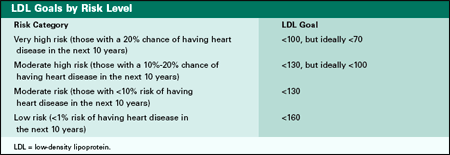Article
Understanding Cholesterol: Do You Know Your Numbers?
Author(s):
Dr. Zanni is a psychologist and health-systems consultant based in Alexandria, Virginia.
Health care providers pay close attention to patients' cholesterol levels—and for good reason: high cholesterol levels increase the likelihood of a heart attack, stroke, and other coronary heart diseases. The good news is that medication, diet, and exercise reduce cholesterol levels and decrease the occurrence of heart disease.
What Is Cholesterol?
Cholesterol is a fat-like substance in the blood. The body's cells need cholesterol, but too much of it creates problems. Approximately two thirds of the body's cholesterol is made and stored in the liver; the remaining cholesterol comes from diet, especially from meat, chicken, fish, and dairy products. A simple blood test measures cholesterol, and laboratory tests report 3 values: low-density lipoprotein cholesterol, called LDL; high-density lipoprotein cholesterol, called HDL; and total cholesterol, which is the sum of LDL and HDL.
LDL and HDL have very different functions, and problems occur when patients have either too much LDL or too little HDL. Think of LDL as the carriers taking cholesterol from the liver to cells. Once the cells have what they need, they refuse delivery. The carriers do not know what to do with the extra cholesterol, so they dump it in the bloodstream and return to the liver for another batch.
Now think of HDL as the clean-up crew; they travel the bloodstream hauling away the excess, but if there are too few HDL workers, they cannot clean up all the excess. This excess cholesterol then clogs arteries and causes heart damage. This is why LDL is called bad cholesterol and HDL good cholesterol. Ideally, patients should have a low LDL number (fewer carriers) and a high HDL number (more clean-up crew). Of the 2 cholesterol types, elevated LDL levels are considered especially unhealthy.
Cholesterol levels are reported in units of measurement called milligrams per deciliter of blood (mg/dL). Generally, providers refer to the numbers without saying the units. All 3 cholesterol values are required to determine if a person is in a healthy or unhealthy range. Table 1 summarizes the various ranges.
Triglycerides
Along with cholesterol levels, doctors also monitor another type of fat in the bloodstream—triglycerides. The body needs triglycerides, but excess triglycerides leads to heart disease and swelling of the pancreas. Less than 150 is considered normal, 150 to 199 is borderline high, 200 to 499 is high, and greater than 500 is considered very high.
Table 1

What Is an Ideal Cholesterol Level?
The numbers in Table 1 provide general ranges, but they may not reflect a person's ideal cholesterol level, especially for LDL. To determine your ideal LDL level, doctors assess risk for coronary disease based on such factors as diabetes and hypertension, age, tobacco use, weight, lack of exercise, elevated triglycerides, and family history of heart disease. Recommended LDL levels are based on these risk factors (Table 2).
Table 2

Treatment
To lower cholesterol levels, your doctor may first recommend lifestyle changes. These include the following:
- Exercise regularly; start slow and work up to 30 to 60 minutes a day. Strenuous workouts are not necessary; simply walking 30 minutes a day can be effective.
- Limit the amount of fat in your diet, especially saturated fats and trans fatty acids. Read labels carefully for nutritional values. Less than 10% of calories should come from saturated fat, with total fat intake ranging from 20% to 35% of calories. Cholesterol consumption should be less than 300 mg/day. For patients with extremely high cholesterol levels, less than 7% of calories should come from saturated fat, and consumed cholesterol should be less than 200 mg/day. A consumer pocket guide can help track daily fat and cholesterol consumption.
- Increase cholesterol-lowering foods. Five to 10 g of soluble fiber daily from oatmeal, oat bran, beans, cruciferous vegetables (eg, broccoli, cabbage, cauliflower, kale) and fruits decrease LDL about 5%. Daily walnuts and almonds may reduce LDL 12%, but these are high in calories.
- If you are overweight, lose the extra pounds. Avoid fad diets; strive for a balanced diet that reduces total calories and fat intake.
- Quit smoking. If your triglycerides are also high, reduce or eliminate alcohol consumption.
Because the body manufactures cholesterol, exercise and diet may not be enough to lower cholesterol levels, and medication may be necessary. Most medications will decrease cholesterol levels 30% to 40%. Some patients require more than 1 medication. This is especially true if triglycerides are high.

All medications have side effects, though not all people may experience them. Side effects associated with cholesterol- and triglyceride-lowering drugs include intestinal problems, constipation, flushing, gout, gallstones, liver and kidney problems, nausea, muscle weakness, and cramps. Your doctor will monitor for these side effects, but if you experience any of them, call your doctor. He or she may ask you to come in for blood work and/or change your medication.
Take-away Message
Elevated cholesterol is called a silent killer because people rarely have symptoms until heart disease strikes. For this reason, it is important to know your numbers!
Newsletter
Stay informed on drug updates, treatment guidelines, and pharmacy practice trends—subscribe to Pharmacy Times for weekly clinical insights.






